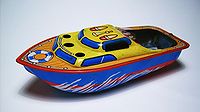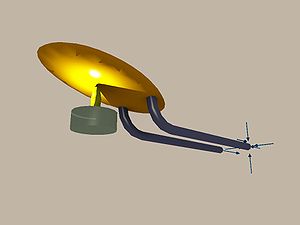
Pop pop boat
Encyclopedia

Heat engine
In thermodynamics, a heat engine is a system that performs the conversion of heat or thermal energy to mechanical work. It does this by bringing a working substance from a high temperature state to a lower temperature state. A heat "source" generates thermal energy that brings the working substance...
without moving parts
Moving parts
The moving parts of a machine are those parts of it that move. Machines comprise both moving and fixed parts. The moving parts have controlled and constrained motions....
, powered by a candle
Candle
A candle is a solid block or cylinder of wax with an embedded wick, which is lit to provide light, and sometimes heat.Today, most candles are made from paraffin. Candles can also be made from beeswax, soy, other plant waxes, and tallow...
or oil burner. The name comes from the noise the boats make. Other names are putt-putt boat, crazy boat, flash-steamer, hot-air-boat, pulsating water engine boat. Around the world they may be called Can-Can-boot, Knatterboot, toc-toc, Puf-Puf boat, Poof Poof craft, Phut-Phut, or Pouet-Pouet.
Construction

The boat's engine consists of a boiler and one or more exhaust tubes. While a single exhaust tube may be used, two exhaust tubes are much more commonly used. This is because the boiler and the exhaust tubes have to be filled with water, and using two tubes allows water to be injected into one tube while air inside the engine escapes through the other tube. It is more difficult to remove the air and completely fill single exhaust tube types. The boiler and exhaust tubes are usually made out of metal, with tin or copper being common.
Boiler designs vary. Simple metal containers in the shape of a box or cylinder are common. A more efficient boiler can be made by using a metal pan whose top is a slightly concave diaphragm made out of a very thin, springy metal. Many pop pop boats have used a single tube of metal, which is formed into a coil in its center and left straight on both ends to form the exhausts. The coil in this version functions as the boiler.
A heating element of some sort is placed under the boiler. Candles or small oil burners are commonly used.
History
Credit for the first pop pop boat is usually given to a Frenchman named Thomas Piot. In 1891, Piot filed a patent application in the UK for a simple pop pop boat using a small boiler and two exhaust tubes. A 1975 article by Basil Harley mentions a similar boat seen in a French journal from 1880, indicating that this type of toy may have existed for many years prior to Piot's patent.In 1915, an American named Charles J. McHugh filed a patent application for the diaphragm type of engine, which was an improvement to Piot's design. In 1920, William Purcell filed a patent for the coiled tube type of engine. This type of engine has been very common over the years in homemade pop pop boats, due to its simplicity of construction. The Cub Scout book (published by the Boy Scouts of America
Boy Scouts of America
The Boy Scouts of America is one of the largest youth organizations in the United States, with over 4.5 million youth members in its age-related divisions...
) contained a project called a "Jet Boat" for many years. This project used a coil type of engine based on Purcell's design which was placed in a wooden hull. Many commercial pop pop boats have also used this type of engine, due to its low cost.
McHugh filed for another patent in 1926. This was again a diaphragm engine design, refined so that it could be more easily fabricated commercially. In 1934, Paul Jones filed a patent for another diaphragm design which could be produced industrially from simple stamped parts.
Many pop pop boats produced in the 1920s had a single exhaust pipe. Designs using two exhaust pipes are easier to fill, and have been much more common over the years.
Pop pop boats were popular for many years, especially in the 1940s and 1950s. Pop pop boats declined in popularity along with other tin toys in the latter half of the 20th century as plastic toys took over much of the market. While they are no longer produced in as large of numbers, pop pop boats continue to be produced. These toys have come in many varieties over the years. Some have been very simple and inexpensive, while others have been much more ornate and artistic. As with many toys, pop pop boats are often sought by collectors, and the prices paid vary depending on rarity and design.
The pop pop boat featured prominently in the 2008 Japanese animated fantasy film Ponyo. Toy boats with a diaphragm type engine, like the one shown in the film, were produced and sold as a tie-in
Tie-in
A tie-in is an authorized product based on a media property a company is releasing, such as a movie or video/DVD, computer game, video game, television program/television series, board game, web site, role-playing game or literary property...
when the movie was released.
Principle of operation
A pop pop boat is powered by a very simple heat engine. This engine consists of a small boiler, which is connected to an exhaust tube. When heat is applied to the boiler, water in the boiler flashes into steam. The expanding steam pushes some of the water in the exhaust tube, propelling the boat forward. The steam bubble then condenses, creating a vacuum which draws water back in through the exhaust tube. The cooled water that is brought back into the boiler is then heated and flashed into steam, and the cycle repeats. This constant flashing and cooling cycle of the engine creates the distinctive "pop pop" noise for which the boat is named. This noise is more pronounced when a diaphragm type boiler is used. Coil type boilers are much quieter.Note that in pop pop boats with two exhaust tubes, the water is expelled from both tubes during the first phase of the cycle, and drawn in from both tubes during the second phase of the cycle. The water does not circulate in through one tube and out through the other. The internal-combustion analog of the pop pop boat engine is the valveless pulse jet
Valveless pulse jet
A Valveless pulse jet is one of the simplest jet propulsion devices ever designed, and is the simplest form of jet engine that does not require forward motion to run continuously. Valveless pulsejets are low in cost, light weight, powerful and easy to operate...
.
The operation of the pop pop boat may seem surprising, since one might expect that if water is going in and out through the exhaust tube, the boat should merely shake back and forth. But while the water pushed out carries away with it momentum
Momentum
In classical mechanics, linear momentum or translational momentum is the product of the mass and velocity of an object...
, which must be balanced (by Newton's third law) by an opposite momentum on the part of the boat, the water sucked in quickly impinges on the boiler tank and transfers its momentum to the boat. The initial reaction force on the boat (which would pull it backwards) is therefore cancelled by the pushing of the water when it hits the inside of the boiler. The result is that the inflow of water causes no appreciable force on the boat.
Some authors have argued that the reason why the pop pop boat works is that the water being propelled out the back of the boat forms a narrow jet, while the water being drawn back in on the second half of the cycle is drawn in from all directions. This asymmetry may be seen as well in the way in which one blows out a candle: it is easy to extinguish a candle by blowing on it, since all of the air expelled is moving in a concentrated, directional jet. However, it is difficult to put out the flame by sucking in air, since the air being sucked in comes from all directions. This observation, though correct, may be misleading as an explanation of why the pop pop boat moves forward. The asymmetry of the shapes of the inflow and the outflow is a consequence of the viscosity
Viscosity
Viscosity is a measure of the resistance of a fluid which is being deformed by either shear or tensile stress. In everyday terms , viscosity is "thickness" or "internal friction". Thus, water is "thin", having a lower viscosity, while honey is "thick", having a higher viscosity...
of the fluid, whereas the boat would be able to operate in an ideal fluid.
The physics of the operation of the pop pop boat is very similar to that of the "Feynman sprinkler
Feynman sprinkler
A Feynman sprinkler, also referred to as a Feynman inverse sprinkler or as a reverse sprinkler, is a sprinkler-like device which is submerged in a tank and made to suck in the surrounding fluid...
," a submerged sprinkler which is seen to turn weakly or not at all as water is sucked in through it. In both cases, the reaction force on the solid device caused by the sucking in of the fluid is balanced by the fluid impinging on the inside of the device.
See also
- Steam engineSteam engineA steam engine is a heat engine that performs mechanical work using steam as its working fluid.Steam engines are external combustion engines, where the working fluid is separate from the combustion products. Non-combustion heat sources such as solar power, nuclear power or geothermal energy may be...
- Pulse jet enginePulse jet engineA pulse jet engine is a type of jet engine in which combustion occurs in pulses. Pulsejet engines can be made with few or no moving parts, and are capable of running statically....
- Valveless pulse jetValveless pulse jetA Valveless pulse jet is one of the simplest jet propulsion devices ever designed, and is the simplest form of jet engine that does not require forward motion to run continuously. Valveless pulsejets are low in cost, light weight, powerful and easy to operate...
- Feynman sprinklerFeynman sprinklerA Feynman sprinkler, also referred to as a Feynman inverse sprinkler or as a reverse sprinkler, is a sprinkler-like device which is submerged in a tank and made to suck in the surrounding fluid...
External links
- The Pop Pop Pages including extensive references and vendors
- How-to guide for making a pop-pop boat
- 4Physics.com description
- Pop pop boat information, including history and operating instructions
- On-line museum of toy steam engines and steam boats, including the "Miss England" pop pop boat

